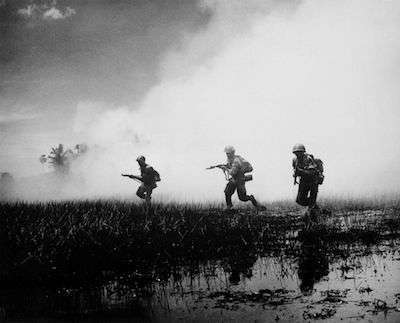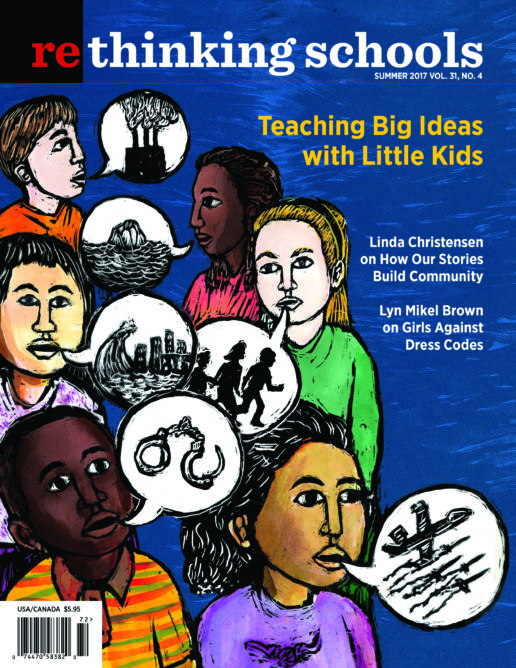From Many Sides Now
Teaching the Poetry of the Vietnam War

I have been teaching the Vietnam War for 16 years, my entire teaching career. The history of the conflict continues to be relevant both in its own right as a singular historical event and as a cautionary tale for students seeking to understand the dangers of our modern — and seemingly endless — foreign wars. At the end of my unit on Vietnam with 11th graders, we have investigated the anti-colonial roots of the conflict, strategies of asymmetric warfare, and the Pentagon Papers. We have also explored the duplicity of the U.S. government during the war, the peace and protest movements against it, and the role of media coverage in shaping the public’s understanding of the conflict.
Students have written persuasively, about whether the United States should have assisted France in its effort to reconquer Vietnam at the close of WWII, and analytically, by comparing excerpts from the Pentagon Papers with President Lyndon B. Johnson’s “Why We Are in Vietnam” speech (highlighting discrepancies between Johnson’s public statements and the government’s private analysis of the war).
But after a sprawling unit like this, nothing crystalizes authentic understanding better, or more efficiently, than poetry — both the reading and writing of it. I use the book From Both Sides Now: The Poetry of the Vietnam War and Its Aftermath, edited by Phillip Mahony. Though the title suggests an oversimplified analysis of the conflict (are there only two sides?), it comes from a Joni Mitchell song of the era that conveys precisely the opposite: Real life is more complicated and confounding than can be summed up by just looking at two sides. Mitchell sings:
I’ve looked at life from both sides now,
from win and lose, and still somehowit’s life’s illusions I recall.
I really don’t know life at all.
Mahony writes that during the Vietnam era, “like the singer in the song, [many U.S. citizens] were tragically awakening to things they really didn’t want to know, things that would change forever their way of looking at their country, their leaders, and their place in the world.”
The “Both” in Mahony’s title actually means he has brought together poets who are both Vietnamese and American (and Vietnamese American), who both opposed and supported the war, Vietnamese veterans who served in the armies of both the National Liberation Front and the pro-American government in Saigon, both civilians and combatants, and both those who lived through the conflict and those who were born in its aftermath. Indeed, a better, but less historically evocative title for Mahony’s collection might have been “From Many Sides Now.”
In the period from 1954 to 1975, which marks the era of deepest U.S. military involvement in Vietnam, 3 million Vietnamese and 58,000 Americans were killed or died as a consequence of the war. In spite of the unimaginable losses incurred by the Vietnamese, in a U.S. classroom it is too easy for U.S. voices to dominate; like the classic 1974 documentary Hearts and Minds, this book acts as an important corrective to that tendency, enabling students to imagine and understand how the policies they have been learning about affected the lives that were shaped — and in many cases ended — by them.
From Nguyen Ngoc Phuong, an activist who died in a South Vietnamese prison while on hunger strike in 1973, we understand the willingness to sacrifice exhibited by a people fighting against the new face of an old enemy, foreign occupation:
My blood flows
To cleanse the subservient spirit
My bones will be piled like a staircase
So younger brothers and sisters can walk up
to the tower of Freedom.
From W. D. Ehrhart, a former U.S. Marine, we understand the deadly desensitization experienced by U.S. soldiers fighting a guerrilla war:
It’s practically impossible
to tell civilians
from the Vietcong;after a while,
you quit trying.
Sometimes the book gives us Vietnamese and U.S. authors describing the same transformative events. For example, multiple poems address the self-immolation of Buddhist monks, a protest method used to draw attention to the oppressive policies of the U.S.-backed government in South Vietnam. Jan Barry, a U.S. Army veteran, writes:
It was quite a sight for a boy from Tennessee:
a Buddhist nun dressed in fire
sitting proudly amid a solemn, silent crowd,
flames and a smoke plume her terrible costume.ÉSafe back at base, Jimmy’s chatter
circled the nightmare he still could taste.
He grinned — shivered — then softly swore:
“Jeesus! How’d we get in this crazy place?”
Nhat Chi Mai, a Buddhist nun, wrote multiple statements outlining her reasons for lighting herself on fire on May 16, 1967, including this poem:
Is appealing for Peace a crime?
Is acting for Peace communism?
I am appealing for Peace
In the name of ManI join my hands and kneel down;
I accept this utmost pain in my body
In the hope that the words of my heart be heard.
Please stop it, my fellowmen!
Not surprising, there are many poems dealing with loss. In a poem titled “Packing,” Vietnamese-born writer Tran Thi Nga writes:
We all wanted to bring our mothers.
None of us could.
We had so many false starts
I never said goodbye to her.
Students also find many references to events we’ve studied in class. For example, D. C. Berry’s poem “Gulf of Tonkin,” or another by David Widup simply titled “Laos” that includes these lines:
The Stars and Stripes says
“Nixon promises no war in Laos!”I stand in the Aerial Port,
on my way to Nha Trang,
and there’s a line of grunts
a mile long,
a snake full of killing evil,
waiting in line.They all died.
Every one of them died,
before anyone knew they were there.
The Lesson
I create a packet of photocopied selections from From Both Sides Now, making sure to include roughly even numbers of pieces by Vietnamese and U.S. authors. There are so many wonderful, powerful, evocative poems that it can be difficult to choose, but I generally aim for 35, enough for every member of the class (including me) to be assigned one poem for a read-around.
I distribute a highlighter and packet to each student and explain we are going to read these poems aloud together and, eventually, each construct a found poem — a poem made up of excerpts and snippets of the poems we are reading. I encourage everyone to volunteer to read one poem for the class. (When selecting the poems, I also pay attention to length; I am always looking to include a few very short poems for kids who have difficulty reading aloud.) Once poems are assigned I tell students to take a few minutes to practice reading their poem — this also gives hesitant readers a chance to check in with me or each other about pronunciation (particularly of Vietnamese names, which can be daunting for non-native speakers of the language).
Since students will construct found poems following our read-around, we talk about how to collect material. I say, “As you listen to your peers read, highlight words, lines, stanzas that move you emotionally, things you find sad, scary, infuriating, confusing, or beautiful. For now, don’t worry about whether all these pieces will fit together in a poem — just focus on the language that creates a powerful emotional response.”
Finally, we are ready to read and highlight. I instruct students to read the poems in a continuous stream (which has the lovely effect of creating one, enormous “found” poem, read in multiple voices), and remind them to read the title and author before launching the first line. Because many of the authors are Vietnamese, I also make clear that I expect kids, almost all of whom do not speak Vietnamese, to do their best to pronounce Vietnamese names — “No, you do not get to say, ‘whatever, whatever,’ in place of the author’s name.” Once the read-around begins, the room fills with the vibrancy of student voices, poetry, and the squeeching of highlighters on paper. It usually takes about 25 minutes for one read-around.
Next I ask students to share a favorite highlighted line or stanza. Students raise their hands and share passages like Jim Nye’s “19 years old, should’ve been/At a high school game/Hitting on a cheerleader,” or Thich Nhat Hanh’s “Listen to this:/yesterday six Vietcong came through my village,/and because of this, the village was bombed./Every soul was killed,” or Lieutenant Nguyen Van Nghia’s “Every night the echoes of Southern gunfire/Tear at my insides.” This sharing helps students who are concerned they did not highlight the “right” thing. Fears are ameliorated when they realize they and their peers highlighted some of the same material. In addition, it gives kids a second chance to highlight new material they too find moving or powerful, but maybe missed on the first read through.
Now it’s time to focus on creating our poems. I ask students to go back through their highlighted material and begin to look for patterns or themes that might serve as the focus of a poem. After a few minutes, I ask for some volunteers to share ideas. I write on the board while students collectively create a list that usually looks something like this:
- The “enemy”
- The trauma of war
- Similarities/differences between Vietnamese and American experiences of the war
- The tactics of war
- The meaning or meaninglessness of the war
By the time we have finished this brainstorming, most students have a thematic direction, so I say, “Now, go back through all the poems and gather more material specifically related to the theme of your poem.” After about 10 more minutes of highlighting, I introduce the requirements of the assignment (at least 25 lines long, made up of at least 10 different authors’ work) and answer lots of questions about the “rules” of found poems: “Can we use just a phrase, not a whole line?” Yes. “Are we allowed to change the tense of a verb?” Yes. “Can we repeat a line?” Yes. This conversation usually ends with me quoting the Chilean poet Nicanor Parra, who writes, “In poetry everything is permitted./With only this condition of course,/You have to improve the blank page.” Once all queries are answered, I send students off to put together their poems.
The next class, we do a read-around of the found poems. One student, Adam, managed to combine the lines of five poets into this single stanza:
Every soul was killed
This murder of brothers by brothers!
I am divided like the land,
Shall live for my country.
Your glowing, searching eyes,
There’s no pride, no regret.
You know your life is no longer yours.
Another student, Lauren, also liked that last line, but it showed up at the start of a stanza:
You know that your life is no longer yours,
So when he got hit and asked me, “How’s my leg?”
“It’s fine.”
It looked fine to me, laying over there.
A trembling Black kid,
Gun-shot and eyes rolling white.
He calls alternatively for Mama and Jesus.
By reading the poems aloud in a continuous stream, students create a new, collective poem with its own organic, unpredictable but always awesome, rhythms, themes, and repetitions.
More importantly, students have spent time occupying the voices of those who fought, suffered, protested, and witnessed the Vietnam War, bringing history off the dusty page and into the realm of relatable experience and lived reality, where the devastation wrought by the war is inescapable, and hopefully an indelible reminder of the necessity of peace.
Resources
- Mahony, Phillip. 1998. From Both Sides Now: The Poetry of the Vietnam War and Its Aftermath. Scribner Poetry.

